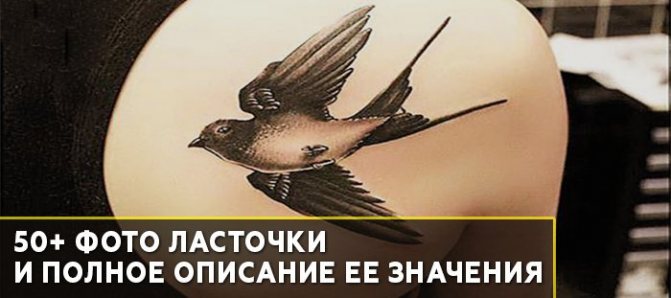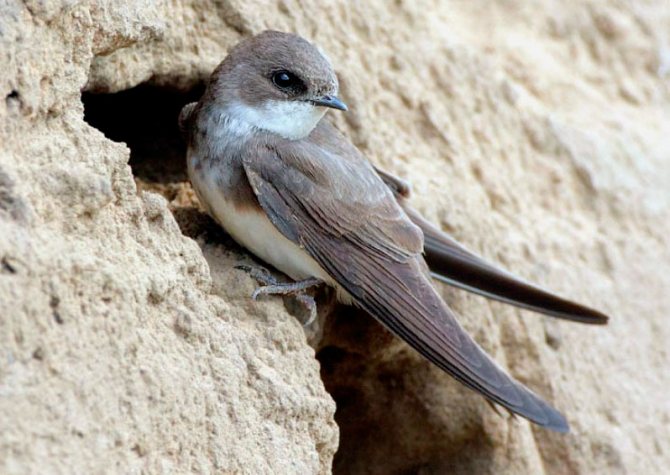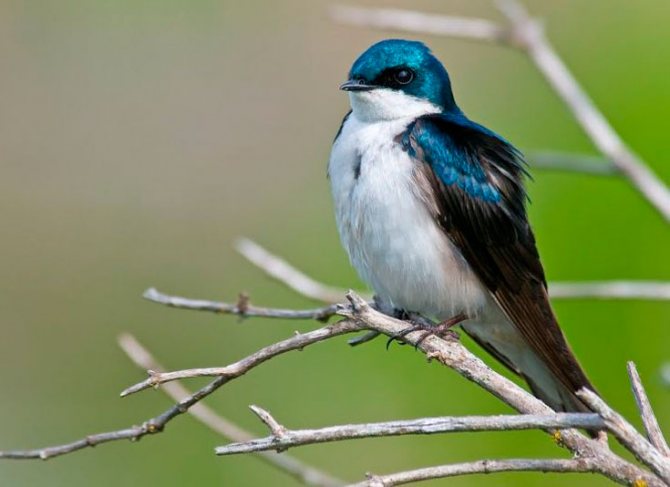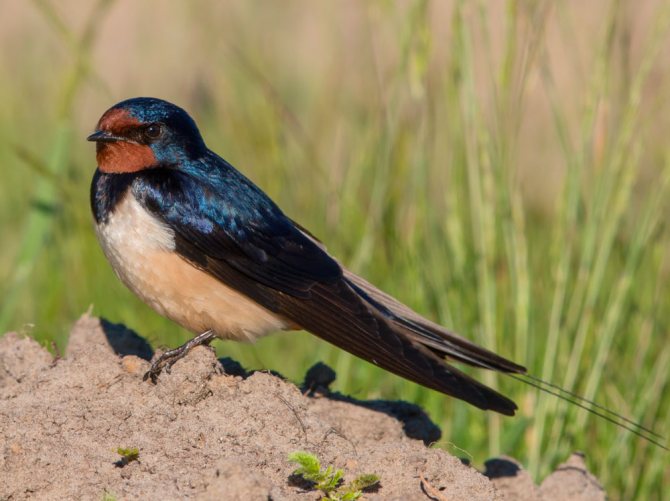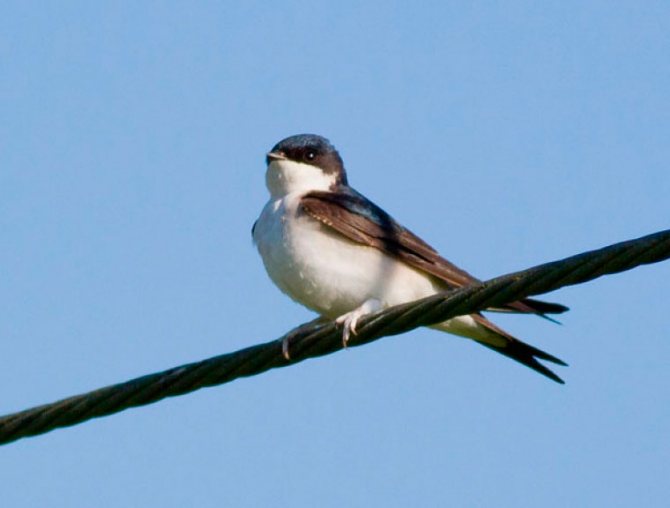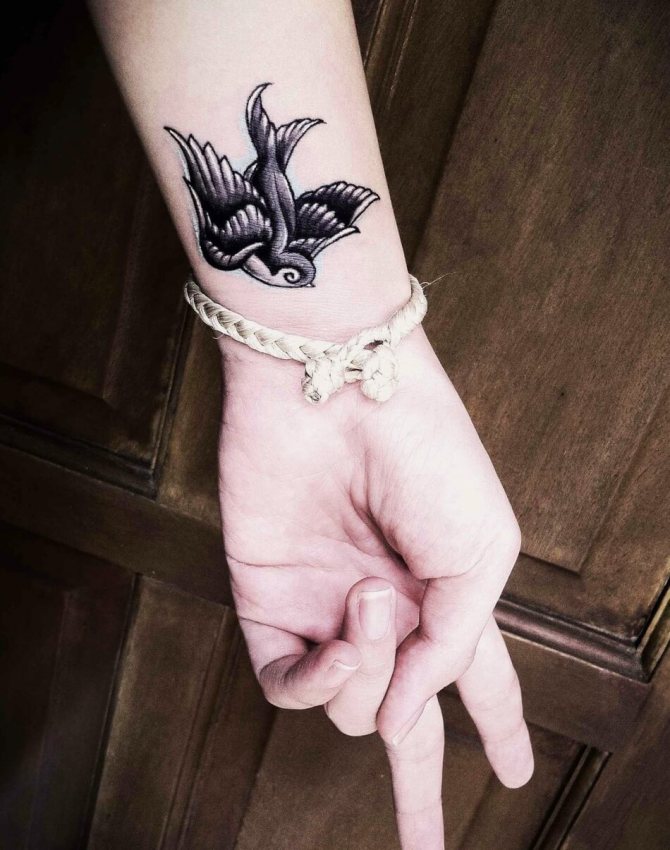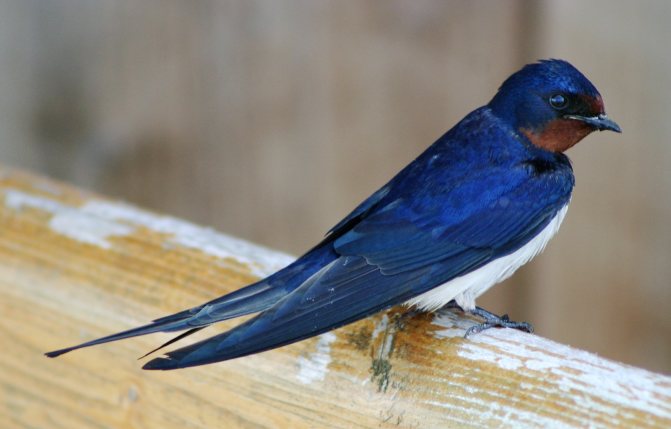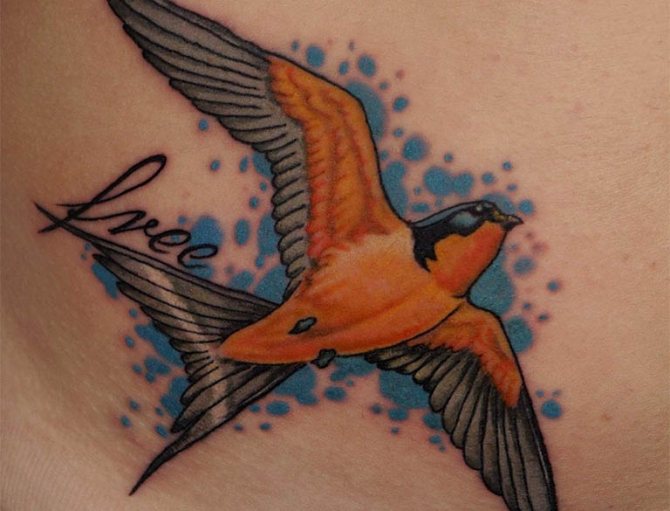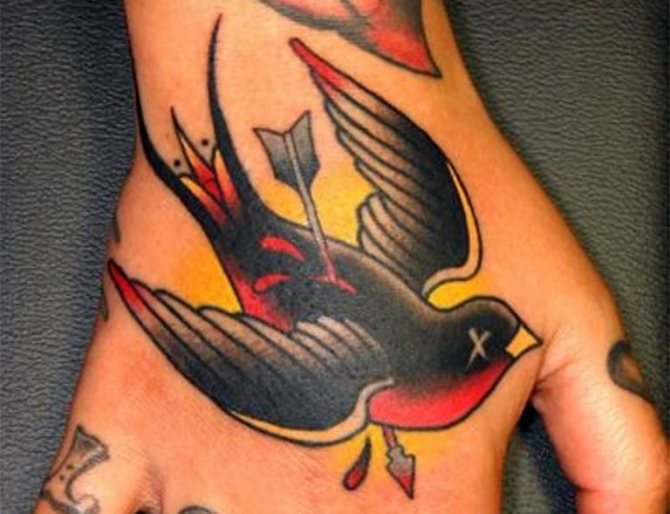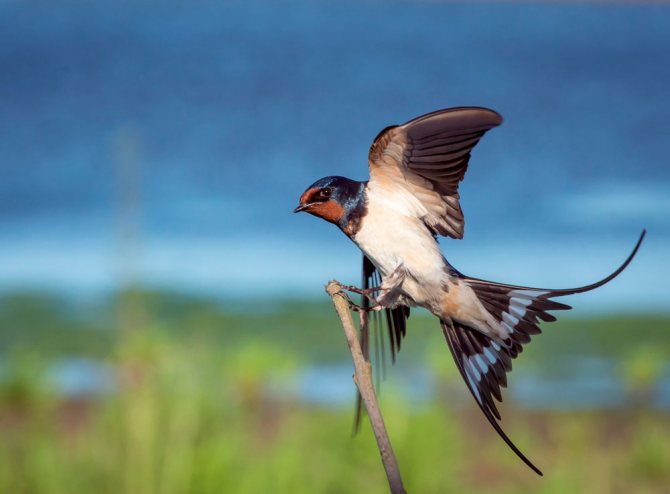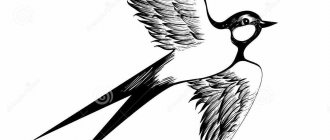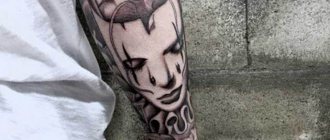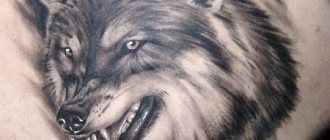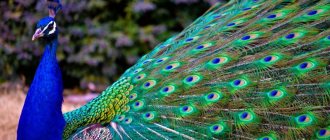Description Swallow; kasatka (country ~) ≈ swift - swallow ground. χελιδόνι Greek. hirundo ---------. In mythological representations swallow has a broad symbolism. The most common motif of the swallow, bringing spring (or day), is found in numerous vesnyanki, carols and related spring rituals, which are reflected in the art. The swallow, arriving from across the sea, is associated with the other world, acts as an intermediary between death and life, distant (foreign) sea and close (own) land, sometimes as a receptacle of the soul of the deceased (the ruler). Hence the other circle of associations associated with it:
Numerous examples where the swallow acts as a symbol of danger, fragility and insecurity of life, happiness, comfort. The main values
|
Egypt
A bird dedicated to Isis as the Great Mother, as well as the gods of the home, as it builds its nest near the house of man.
A symbol of paternal inheritance, because before she dies she builds a nest for her chicks.
According to myth, Isis in the guise of a swallow goes in search of the body of her husband Osiris killed and torn apart / flutters around the pillar that closed the coffin of Osiris[1].
Since the 18th dynasty the swallow was revered as a sacred animal in Thebes.
Swallows are the "eternal northern stars"[2] flying over the River of Life.
Along with other sacred birds (falcon, heron, phoenix) the deceased wishes to be transformed into a swallow so that he "shouts like a victor in the full light of day"[3].
Paired tattoos with a swallow
Paired tattoos always signify unity, spiritual closeness with the other person. They symbolize the indissoluble union of 2 people, their love, devotion and loyalty. The birds can be depicted individually (each with one swallow on the body) or together.
The composition can be different:
- birds flying;
- sitting on a branch;
- huddled together.

Antiquity
Antique symbolism does not distinguish between separate species of swallows.
In Cretan art the swallow appears in connection with the cult of the Great Mother.
In the Greek myth of the two sisters Prokna and Philomela, the gods turn Philomela into a swallow and Prokna into a nightingale. The sounds made by the swallow are explained by the fact that Tereus, husband of Procna, cut out Philomela's tongue.
The swallow (like the dove) is dedicated to Aphrodite, the goddess of love[4].
As messengers of spring are celebrated in ancient Greek chants, their chirping is compared to barbarian tongues.
Stories say that swallows always fly south at the same time, where they winter in the rocks without feathers (Aristotle, Pliny).
The construction of swallows' nests on houses was not always, unlike today's folk beliefs, assessed positively, it could also be a bad omen.
Why so called


Photo of swallows
Swallows rarely descend to the ground, and that only to collect building material for the nest. Mostly swallows are relentlessly circling in the sky. The initial part of the word "fin" from ancient Slavonic is translated as "flying back and forth. That is, the bird "swallow" reflects the lifestyle of this bird - 95% of its life is spent in flight. Other names for the barnacle bird are "swallow", "flipper".
Mesoamerica
Swallow Island, or the country where the sun is born
Tatyana Vitakova To the east of the Yucatan stretches turquoise smoothness of the endless Caribbean Sea. Out of its waves stands the large island of Cozumel, the easternmost point of the Mayan horizon, the place closest to the rising sun. That is why the Maya called it "the country where the sun is born. They also liked to call it Ah-Kusamil-Peten - "The Island of the Swallows", in honor of the goddess with the legs of the swallow Teel Kusam. The patroness of the island is the rainbow goddess Ish Chel, wife of the great sun god Itzamna, protector of women, pregnancy, childbirth, motherhood and women's work. Mothers-to-be came to the island on the day of 8 Sip, dedicated to this goddess in the Mayan calendar.
About 30 dilapidated temples have survived on the island. The first ancient structure we were able to see was El Cedral, the "Cedral", a structure designed for astronomical observations. Its stone walls and roof were picturesquely braided with massive roots of tropical plants. Next door to the "observatory" was the Catholic chapel.
Surprisingly, the Mayan calendar was much more accurate than the Julian and Gregorian! They accurately calculated the duration of the moon around the Earth - 29.53059 days. And the orbit of Venus with an error of only 20 seconds!
The surviving sanctuaries of the island are for the most part extremely simple. As a rule, it is a small quadrangular room with a flat roof and a single entrance.
In the south of the island is an unusual form of temple - in the form of a shell - El Caracol. Squatting through the small entrance, you can see how the walls of the "shell" spiral. Near El Caracol I found an ancient bead of jadeite - perhaps the pyramid has a burial place.
Karakol - "Spirit of the Snail" - the oldest forefather, one of the gods of the underworld - the cave of ancestors, was depicted as an old man sitting in a shell. The space of the cave of ancestors was identified with the space of the curls of the shell and embodied the Milky Way - the path of the soul in space from birth to death and subsequent rebirth, symbolized by the falling star. In the first lunar month, a pregnant woman would go to a pyramid at night to see a shooting star. The Milky Way is the "creator" of all things. At the heart of all Mayan religious and spiritual beliefs was the idea of reincarnation - the constant rebirth of the souls of the dead. The sanctuary symbolized the cave of the ancestors and was the main place of worship.
Copyright © Copyright: Tatyana Vitakova, 2009 Certificate of Publication №2904080762
Slavs
A pure, holy bird, endowed with feminine symbolism and combining the heavenly and chthonic beginnings. The swallow is likened in song to the Mother of God:
"Oh on the Danube, on the shore, There the swallow was bathing, It's not the swallow, it's the Mother of God..."
The swallow and the dove are the birds loved by God. The swallow praises God with its singing. Its chirping is perceived as a prayer: "Holy God, Holy strong, Holy immortal, have mercy on us. In the folk legend of Christ's crucifixion, the swallows tried to relieve Him of His torment by shouting "dead, dead!", stealing nails, pulling thorns from His crown, and carrying water to Him.
Explanation of the split tail:
- According to South Slavic legends, the swallow after the Flood saved man from a bloodthirsty snake, which bit off her tail, making it bifurcated.
- The swallow saved the sun from the snake that devoured it, hiding the sun under its wing or carried it high into the sky.
- In Bulgarian legends, the swallow becomes the bride of the sun, or the girl who was betrothed to the bandit. As she flees, she is grabbed by her veil or hair and a part of it is torn out, which causes the swallow to have a split tail.
- In Polish legend, the appearance of this bird "cut" in the tail and red goiter is associated with the punishment of the swallow for stealing from the Mother of God scissors and a ball of red thread.
The swallow is the patroness of the home and livestock:
- A swallow's nest under the roof ensures happiness in the home.
- If the swallow leaves the nest, the whole family in the house will die out.
- Whoever kills a swallow will have no luck in rearing cattle, and whoever destroys its nest will be rendered homeless or blinded, he will have freckles on his face, his mother or one of his household will die, a cow will die, a cow will lose milk or be milked with blood.
- The Georgian says the swallow's nest protects the home from fire, and the swallow can burn the house of the one who robbed its nest - not without reason - it has a red spot as if from a burn.
- In this regard the Russian omen says that a girl will soon marry if a swallow makes a nest in her house or flies into her window.
- If swallows and doves fly near the house, when the wedding is celebrated, the young couple will be happily married.
- Whoever carries the heart of a swallow will be loved by women.
The swallow and its nest are used in love magic.
The swallow is the messenger of spring. It is said: "The swallow begins spring, but the nightingale ends it. In the songs, she is called the key-keeper: she brings from across the sea golden keys, which unlocks the summer and closes the winter. More often the flight of L. is timed to coincide with the Annunciation (25.III/7.IV). In some areas of southern Russia on the Forty Martyrs (9/22.III) for the arrival of birds baked "flapjacks" with open wings.
In the northwestern provinces the swallows fly in on St. Yegor's day (23.IV/6.V). At that time the swallows prepare for plowing, fry eggs and go to the fields. The swallows are chirping:
"Men in the field, men in the field, and broads to fry eggs!" Or, "They flew away - threshing, they flew away - threshing, they flew in - pa-a-shut!"
Sometimes in a swallow's chirp one can hear a complaint that the storehouse was empty for the winter - sparrows ate all the grain. In spring at the sight of the first swallow they try to wash their faces to avoid freckles, pimples, or sunburns. Washing their faces, they used to say:
"Lastivko, lastivko! Na tobi vesnyanky, give me meni bilyanky!".
It is also believed that if you wash your face at the first swallow, you will become frisky and cheerful, get rid of sleepiness and sickness.
The Ukrainians, Belarusians and Poles have widespread beliefs about the wintering of swallows in the water. On the day of St. Simeon Stolpnik (1/14.IX) the swallows gather together and complain to this saint that sparrows occupied their nests, and children ruined them. Immediately thereafter, or on the Exaltation (14/27.IX), they hide in wells to get to the Irium as soon as possible that way. In the autumn, people try not to draw water from wells, so as not to prevent swallows to fly into the irium. According to other beliefs swallows hide in rivers and lakes, clutch their legs or wings into chains and sleep under water. In spring only young swallows fly out of the water, but the old ones lose their feathers and turn into frogs.
The swallow bears a resemblance to the weasel:
- Their names are related in origin;
- The swallow, like the color of a weasel, is used to determine the suitability of cattle;
- At the sight of the first swallow they take the ground from under their feet and look for a hair in it: what color it will turn out to be, that is the suit of the horse, and it should be bought so that the house man will like it;
- A swallow flying under a cow is considered to be the cause of blood in the milk, just like a weasel running under a cow.
In the riddles, the chirping of the swallow is represented as foreign-language speech:
- "it spoke in German", "it babbled in Tatar", "it started up in Turkish", etc.;
- In Croatia they believe that the swallow knows Latin, and they translate its singing in Latin words;
- In Bulgarian songs swallows are called "gramaticians" - scholars, scribes;
- With the Serbs the learned men are said to be as learned in books as swallows.
Keeping at home
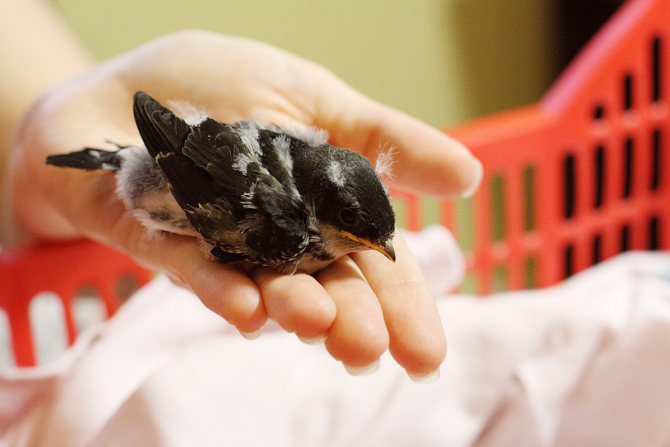

Swallow in human hand photo
These lovely birds end up in human hands for a variety of reasons: for example, an adult bird has broken a wing and cannot fly with the family for the winter, or a chick has fallen out of the nest and has no chance of survival. This is how swallows become pets quite by accident. Left alone with helpless, squeaky baby swallow, many do not know how to nurse and what to feed the chick. To keep a swallow at home is not an easy task. Living in a cage, the bird will not look for food and beg for food. Therefore, it will have to feed it by itself.
What to feed swallow chick
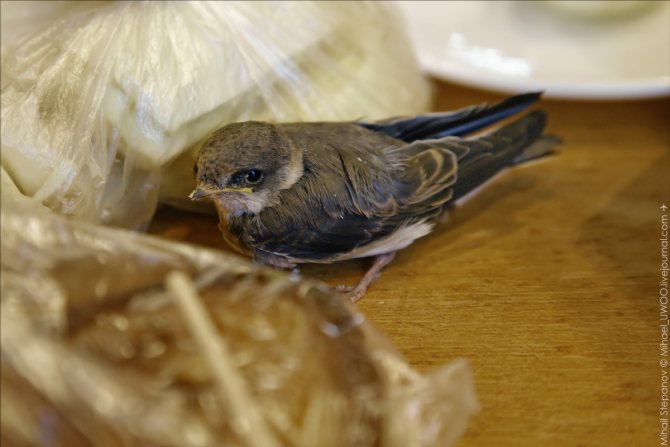

Swallow feeding photo
If the chick is very tiny, the first days it is fed with a dairy product (cottage cheese, milk) from a dropper. Nestlings and adult birds are fed simple raw or cooked lean meat. Make minced meat and feed it to the swallow. The bird is fed a piece of food the size of a walnut at a time. They are fed only during the daytime.
Swallows are fed every 2-3 hours and only fresh food.
A sample menu for a baby swallow:
- A pinch of skimmed cottage cheese + a spoonful of insects + dry gammarus (fish food) or daphnia. Mix everything, make a tiny ball and put it in the bird's mouth;
- Boiled egg + carrots + breadcrumbs. Mash the ingredients, mix, form a ball;
- Swallow chicks should not be fed eggshells, bread crumbs, food intended for pets.
If you do not regularly give a complex of vitamins, then soon the chick's feathers will begin to fall out, bone deformation will occur and stomach function is disturbed. Improper nutrition leads to the chick's early death.
If you do manage to get a young bird out, it probably won't want to live in the wild anymore, and will prefer to stay with a human. A human-fed bird in the wild will die.
House swallows are kept in spacious cages or aviaries - because swallow likes to be in constant motion. Some birds get so accustomed to people that they may like a branch of a garden tree or a perch.
China
"Yang" is a messenger of spring. There was a belief that they winter on the sea inside the shells.
It brings family happiness, success, and heralds the birth of children, when it builds its nest under the roof of the house. The first rites of fertility rituals are associated with the return of the swallows.
Daring, danger, loyalty, future success, favorable changes.
In the system of images, considering the five types of human relationships, it symbolizes the relationship between older and younger brothers.
In art it is associated with the waves and willows. ???
Christianity
Medieval animal literature retains many positive assessments of the swallow:
- In one of the bestiary it is indicated that swallows give their chicks sight with the juice of crushed celandine - this was interpreted as a symbol of the opening of the eyes of the dead at the Last Judgement;
- the young swallows, who are always hungry and thirsty, are a symbol of spiritual thirst (food) and are likened to those who have made a prayerful request to God;
- they were also identified with meek souls ready for repentance;
- their annual (as ijuravs) return with the coming of spring and/or the idea of swallows wintering in clay dens (a state similar to death) gives the swallow significance as a symbol of new life and resurrection from the dead.
In Renaissance art the swallow, nesting under the eaves of the house (in the wall hole) is often present in scenes of the Annunciation and Nativity as a symbol of the Incarnation and Resurrection of Christ.
Distribution
Range


Numerous populations of swallows are found on all continents, except Australia, circumpolar regions and northern temperate zone.
Habitat is southern countries. Asia, Africa, southern Europe - the weather conditions of these countries allows a sedentary lifestyle. In addition, there is a lot of food.
Areas of distribution of the family of swallowtails:
- Northern Europe. Exceptions - Scandinavia, Kola Peninsula;
- North, South America. In the North, these birds live and breed, in the South - winter;
- Africa. Nesting in the north of the continent;
- Middle East, China, Japan.
Habitats


Urban swallows prefer to settle in towns, among masonry buildings. Families live under eaves, making themselves multi-roomed noisy apartments. Rustic swallows prefer to live away from urbanized areas. They choose small settlements and undergrowth as their habitat. Coastal species live in ravines near reservoirs.
Swallows originally lived only in rocky areas, but later adapted to life in settlements and undergrowth. They are patient, hardy creatures that adapt to any terrain and climate. The most important for Swallow is availability of food and place for building a nest. Swallows can be met in towns and in rocky caves, at the edge of woods, and more often along lakes and rivers.
Emblematics
Swallow
"The swallow takes its food not in a sitting position, but in flight - so should man seek heavenly things away from earthly goods... The swallow flies over the seas when winter and cold is coming - so should man flee from the sorrows and cold of the world and in the warmth of love wait for the frost of temptation to leave his soul." Unterkicker
The swallow flying toward the sun.
- I am drawn to its benevolent influence.
A symbol of the kind attitude and beneficial influence of friends that brings us joy. For this reason we are more inclined to communicate and spend our time with those who are more pleasant and close to us in character. EMSI 35-10, p. 253
A swallow on the roof of the house.
- I will visit you as a friend, but I will not be your servant.
Symbol of a cold man who "befriends us only when the sun shines over us and we prosper, but if misfortune befalls us, he leaves us and does not linger for a moment to serve us in the slightest to his detriment, if it does not benefit him. Although it is impossible to expect everyone to help us in trouble, nevertheless having this quality is the true characteristic of a warm and faithful friend. Thus the swallow stays with us while our warm summer suits her, but leaves us immediately when the cold comes." EMSI 19-9, p.184
A swallow flying over the sea.
- I need to find somewhere to winter in the warmth.
A symbol of the conventional view of friendship, as in the previous picture. "When the sun shines brightly, and your home is plentiful, Friends come to you in multitudes. But when the winter of your days has come, They, like swallows, fly away to warmer climes. EMSI 19-10, p.184.
Flying swallow.
- I cannot be bound.
Symbol of a stubborn and willful mind, on which neither kindness nor good treatment have no effect. The swallow, unlike other birds, is difficult to tame and make it live with us more than it pleases. EMSI 29-8, p.224
Appearance and features
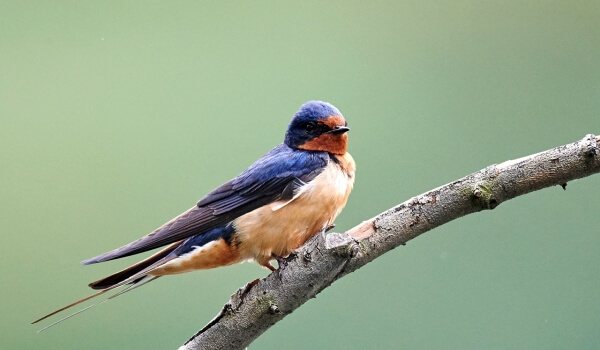

Photo: The swallow bird
The swallow is hard to confuse with any other bird. It is small, moves quickly through the air, and has a physique characteristic of all swallows. The body of these birds is slightly elongated and streamlined. The tail is divided into two narrow parts by a notch, wings are long and narrow. The head of the animal is slightly flattened, and the beak is very short.
Swallows are very small, no larger than the average sparrow. Their body length is usually about seventeen centimeters. The wingspan is twenty to thirty-three centimeters. The weight is also tiny, only eighteen grams. The coloration of feathers in different species of the family may differ slightly. The top of these birds are the same - blue-black with a metallic sheen. The bottom, however, is different. City swallows are pure white at the bottom, while country swallows are beige.
Interesting fact: The swallow's flight is nimble, fast. The rustic species is characterized by a more rapid flight. On average, such birds make about five wingbeats in one second.
The village swallows may have small brown spots on the neck and forehead. The legs of all swallows are covered with down. There are no differences in appearance of females and males. Only young and adults differ from each other. The first have a duller color of feathers - grayish-black.
Adults and young birds moult once a year. Swallows have a prolonged molt period. It lasts from August to March. Plumage changes gradually: first small, then large. Swallows are small and very communicative birds. But their voice is inexpressive and weak.
The Art
The motif of a swallow, bringing spring (or day), can be found in numerous vesnyanki, carols and related spring rituals, which are also reflected in the fine arts.
The arrival of the swallow is depicted on a Greek pelika by Euphronius in the late 6th century B.C. accompanied by the text:
- "Look, a swallow!"; - "Yes, a swallow, by Hercules"; - "Here it is! It's already spring."
There are numerous examples, when the swallow acts as a symbol of danger, fragility and unreliability of life, happiness, comfort. These symbolic meanings of the swallow are developed in literature and art up to the present day:
"The blind swallow will return to the hall of shadows on wings cut" - in O. E. Mandelstam about the forgotten word that needs to be said.
The poet Vecke uses this symbol to convey the pathos and inexorable nature of time, drawing analogies with other symbols (???).
Ad vocem
Riddles:
- "Small himself, but he has been over the sea."
- "Shitovilo bitovilo spoke in German" - the swallow as a symbol of a chatty woman.
Proverbs, proverbs, omens, symbolism:
- "The swallow starts the spring (day), but the nightingale ends it."
- "Who at the first swallow washes with milk, will be white."
- "Early swallows - for a happy year."
- "High-flying swallows for a bucket."
- "The first swallow."
- "One swallow (yet) makes no spring" is already found in Aristotle and Aristophanes.
Social structure and reproduction
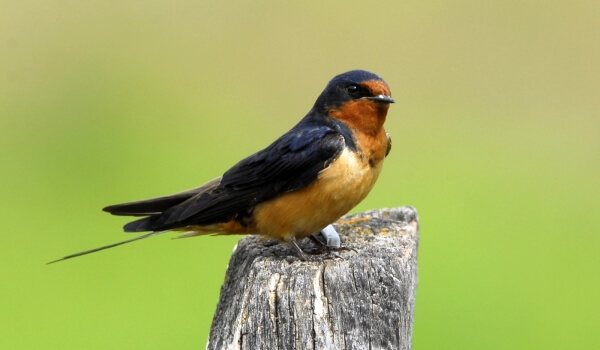

Photo: Swallow bird
Swallows are single-loving birds. If they create a pair, it is for a long time. Cases of polygamy are quite rare in this family. The formation of pairs begins with the arrival of the first warmth - in early spring. At this time, males spread their tails and chirp loudly to attract the attention of a female they like.
Having found a suitable partner, the birds begin to mate. During the season, each female is able to raise two broods of chicks. The female does not lay more than seven eggs at a time. Most often she lays four or five. Swallows-parents hatch eggs for about sixteen days. They take turns in this process. Nestlings are born very tiny. Their size rarely reaches even four centimeters.
Nestlings come into the world absolutely helpless, at first they have no plumage at all. During the first weeks, all the care for their offspring falls on the new parents. They feed the babies together for three weeks. After that, the birds spend a few days training the young. They teach them how to catch insects and fly. Then the offspring leave the parental nest and join the rest of the swallows.
The life of swallows is not that long, averaging four years. However, there are exceptions in nature. Some individuals live up to eight years. Females can give birth to offspring already in a year after birth. The first brood is usually not numerous, the second and all following ones are much more numerous.
Bibliography
- MNME -
Toporov B. H.
, Swallow // Myths of the Peoples of the World. Encyclopedia: in 2 vols. / Ed. by S. A. Tokarev. - M.: Sov. Encyclopedia, 1991. VOL. 2 - SMES - M. GURA A.
Gura AV.
Swallow // Slavic mythology. Encyclopedic Dictionary. Ed. 2-th. - M.: International relations, 2002 - Ibid.
Jobes G.
Dictionary of mythology, folklore and symbols, pt 2, N. Y., 1962, p. 1515-16 < MNME - D.
Henkel A.
Henkel A. , Schüne A., Emblemata. Handbuch zur Sinnbildkunst des 16. and 17. Jahrhunderts, Stuttg., 1967, S. 872-75 < MNME -
Gura A. V.
The symbolism of animals in the Slavic folk tradition. М., 1997. С. 618-633 < SMES.



